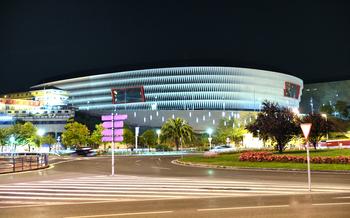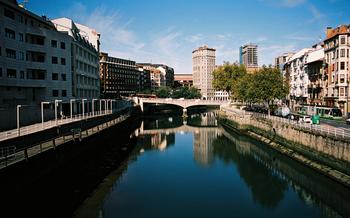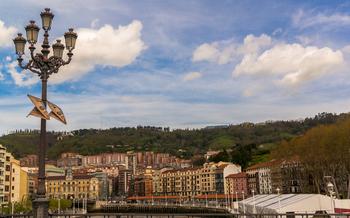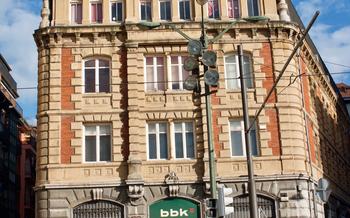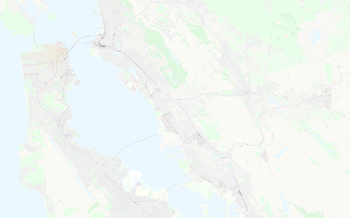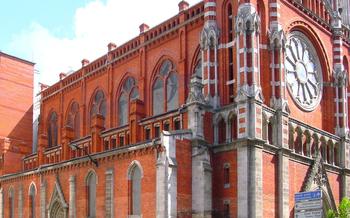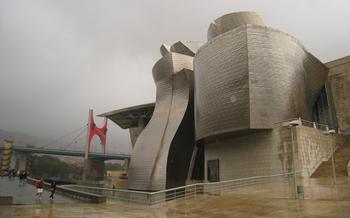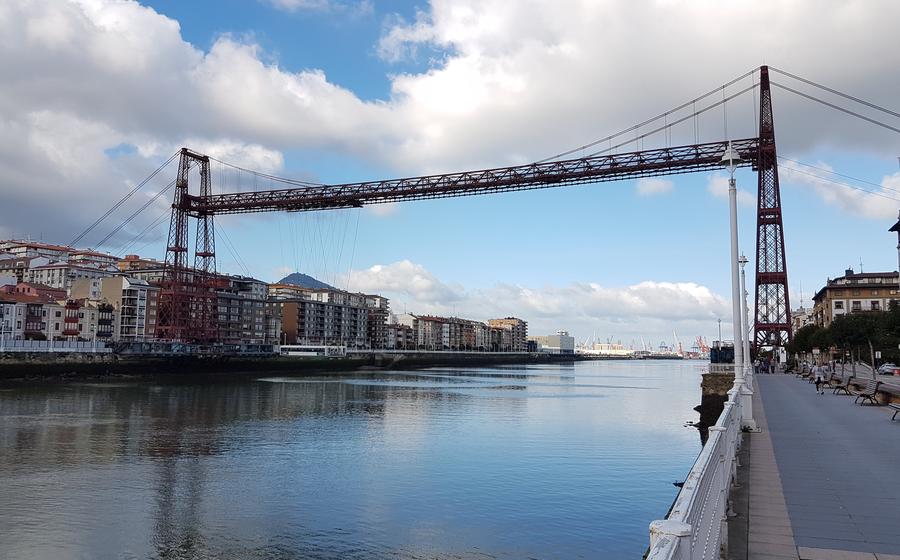
Vizcaya Bridge
- Vizcaya Bridge: A UNESCO World Heritage Site
- Location and Accessibility
- History of the Vizcaya Bridge
- Technical Details of the Vizcaya Bridge
- The Experience of Crossing the Vizcaya Bridge
- Significance of the Vizcaya Bridge
- Views from the Vizcaya Bridge
- Visiting the Vizcaya Bridge: Practical Tips
- Exploring the Surrounding Area
- Bilbao's Culinary Delights
- Bilbao's Cultural Scene
- Bilbao for Art Enthusiasts
- Bilbao for Shopaholics
- Bilbao's Green Spaces
- Insider Tip: A Unique Perspective
Vizcaya Bridge: A UNESCO World Heritage Site
The Vizcaya Bridge, a stunning feat of engineering and architecture, stands proudly over the Nervion River, connecting the municipalities of Portugalete and Las Arenas in Bilbao, Spain. This magnificent structure, recognized by UNESCO as a World Heritage Site, is a testament to the Basque Country's rich industrial heritage.
The bridge's historical significance is deeply intertwined with Bilbao's transformation from a small fishing village to a thriving industrial hub in the late 19th century. Its construction, spanning from 1887 to 1893, was a remarkable achievement in an era marked by rapid industrialization. The bridge's innovative design, featuring a suspended gondola system, set a new standard for bridge engineering and became a symbol of Bilbao's industrial prowess.
The Vizcaya Bridge's architectural design is a masterpiece of simplicity and elegance. Its slender steel towers, reminiscent of Gothic cathedrals, soar gracefully above the river, creating a striking silhouette against the sky. The intricate latticework of the bridge's framework showcases the precision and artistry of its construction, while the suspended gondola, gliding smoothly across the river, adds a touch of dynamism to the overall structure.
The bridge's engineering marvels extend beyond its aesthetics. Its innovative use of suspended cables and counterweights allows the gondola to transport both passengers and vehicles across the river without obstructing the passage of ships below. This ingenious design, coupled with the bridge's ability to withstand strong winds and tides, makes the Vizcaya Bridge an exceptional example of engineering prowess.
As a symbol of Bilbao's industrial heritage, the Vizcaya Bridge represents the city's transformation from a humble fishing village to a major industrial center in the 19th century. The bridge's construction was driven by the need to connect the iron ore mines of the Basque Country with the city's shipyards, facilitating the transportation of raw materials and finished goods. The bridge's success played a crucial role in Bilbao's industrial growth and solidified its position as a leading player in the global steel industry.
Location and Accessibility
The Vizcaya Bridge is conveniently situated in the Portugalete municipality, just across the river from Bilbao city center. Its strategic location makes it easily accessible by various means of public transport. The metro station of Portugalete is a short walk away, providing a direct connection to Bilbao and other parts of the metropolitan area. Additionally, several bus lines stop near the bridge, offering convenient options for those who prefer surface transport.
The proximity of the Vizcaya Bridge to Bilbao's city center allows visitors to seamlessly combine a visit to this iconic landmark with a broader exploration of the city. Whether you choose to walk, take a short bus ride, or hop on the metro, you can easily reach the bridge from Bilbao's main attractions, such as the Guggenheim Museum, the Old Town, and the Ensanche district.
The scenic views of the Nervion River and the surrounding landscape further enhance the journey to the Vizcaya Bridge. As you approach the bridge, you'll be greeted by breathtaking vistas of the river, its estuary, and the verdant hills that embrace Bilbao. This picturesque setting makes the journey to the bridge an experience in itself, setting the stage for an unforgettable encounter with this architectural marvel.
History of the Vizcaya Bridge
The Vizcaya Bridge owes its existence to the vision of Alberto Palacio Elissague, a Basque engineer who was determined to create a means of transportation that would connect the industrial areas of Portugalete and Las Arenas across the Nervion River. Palacio's design, inspired by the transporter bridges in France and England, was considered a daring and ambitious undertaking at the time.
The construction of the bridge began in 1890 and faced numerous challenges, including the need to work with limited resources and the complexities of the terrain. The bridge's towers, made of iron and steel, had to be carefully positioned and anchored into the rocky banks of the river. The gondola, which carries vehicles and passengers across the river, was meticulously assembled and tested to ensure its safety and stability.
After three years of construction, the Vizcaya Bridge was finally inaugurated on July 28, 1893, amidst great fanfare and celebration. The bridge quickly became a vital link between the two sides of the river, facilitating the transportation of goods and people. It also played a significant role during the Spanish Civil War, serving as a strategic crossing point for troops and supplies.
Technical Details of the Vizcaya Bridge
The Vizcaya Bridge stands as a testament to engineering ingenuity and precision. Its dimensions are staggering, with a length of 164 meters and a height of 45 meters above the Nervion River. The bridge's weight is equally impressive, estimated at approximately 2,000 tons.
The structural components of the bridge are a marvel of engineering. Two massive towers, each weighing over 600 tons, anchor the bridge to the river banks. These towers support a network of steel cables that suspend the gondola, which ferries passengers and vehicles across the river. The gondola itself is a marvel of balance and efficiency, capable of carrying up to six cars and 200 passengers at a time.
The functioning mechanism of the bridge is a masterpiece of simplicity and effectiveness. The gondola is attached to a system of pulleys and counterweights, which are powered by an electric motor. This system allows the gondola to glide smoothly across the river, with minimal effort and energy consumption.
The Vizcaya Bridge's carrying capacity and frequency are testaments to its efficiency and reliability. It can transport up to 200 passengers and six cars per crossing, with a frequency of approximately eight minutes. This ensures a steady flow of traffic, minimizing waiting times for passengers.
The Experience of Crossing the Vizcaya Bridge
Crossing the Vizcaya Bridge is a unique and thrilling experience that offers breathtaking views and a sense of awe. Passengers board the spacious gondola, which can accommodate up to six vehicles and several dozen pedestrians, and embark on a short but memorable journey across the Nervion River.
As the gondola slowly ascends, panoramic vistas of Bilbao and its surroundings unfold before your eyes. The city's skyline, with its iconic buildings and verdant hills, forms a picturesque backdrop. The Nervion River meanders below, its waters reflecting the changing colors of the sky.
The ride, which lasts for approximately five minutes, provides ample time to soak in the scenery and capture some stunning photographs. The gentle rocking motion of the gondola adds to the overall experience, creating a sense of tranquility and wonder.
Whether you're a first-time visitor or a seasoned traveler, crossing the Vizcaya Bridge is an unforgettable experience that should not be missed. It offers a unique perspective of Bilbao, combining history, engineering, and natural beauty in one unforgettable journey.
Significance of the Vizcaya Bridge
The Vizcaya Bridge is a remarkable feat of engineering and architectural innovation. Its construction in the late 19th century showcased the ingenuity and skill of the engineers and architects involved. The bridge's unique design, combining the principles of a transporter bridge and a suspended gondola, set a precedent for future bridge construction.
The Vizcaya Bridge has played a pivotal role in the urban development of Bilbao. Its construction facilitated the expansion of the city across the Nervion River, connecting the industrial areas of the left bank with the residential and commercial districts on the right bank. This connection spurred the growth of Bilbao as a major industrial center and contributed to its transformation into a modern metropolis.
The Vizcaya Bridge stands as a symbol of the Basque Country's rich industrial legacy. It represents the region's pioneering spirit and innovative approach to engineering and construction. The bridge's enduring presence as a functional and iconic landmark has earned it recognition as a UNESCO World Heritage Site, solidifying its status as a global symbol of industrial heritage and engineering excellence.
Views from the Vizcaya Bridge
The Vizcaya Bridge offers breathtaking panoramic vistas that extend far beyond the immediate surroundings of the Nervion River. From the gondola, visitors are treated to a bird's-eye perspective of Bilbao and its sprawling cityscape, with the iconic Guggenheim Museum standing out as a beacon of modern architecture. The verdant hills that encircle the city provide a picturesque backdrop, while the shimmering waters of the Nervion River add a touch of serenity to the scene. As the sun rises or sets, the sky transforms into a vibrant canvas of colors, casting a warm glow on the cityscape and creating a truly magical atmosphere. Whether you're a photography enthusiast seeking that perfect shot or simply someone who appreciates the beauty of nature and urban landscapes, the views from the Vizcaya Bridge are sure to leave you awestruck.
Visiting the Vizcaya Bridge: Practical Tips
To make the most of your visit to the Vizcaya Bridge, consider the following practical tips:
-
Recommended time of day: For the best experience, aim to visit the bridge in the morning or evening. These times offer optimal lighting conditions, allowing you to fully appreciate the bridge's architectural details and the stunning surrounding landscapes.
-
Ticket prices and operating hours: The bridge is open to the public daily, with varying operating hours depending on the season. Standard ticket prices apply, offering access to both pedestrian and gondola crossings.
-
Accessibility: The Vizcaya Bridge is wheelchair and stroller accessible, ensuring that all visitors can enjoy the experience. Ramps and elevators are available at both ends of the bridge, providing a convenient and accessible crossing for all.
-
Photography opportunities: The Vizcaya Bridge presents numerous photo opportunities. Capture picturesque views of the bridge from various angles, showcasing its grandeur against the backdrop of the Nervion River and the surrounding cityscape.
Exploring the Surrounding Area
Beyond the Vizcaya Bridge, the surrounding area offers a wealth of attractions for visitors to explore. The historic center of Portugalete, where the bridge is located, boasts charming streets, medieval buildings, and the iconic leaning tower of the Church of Santa Maria.
The Maritime Museum Ria de Bilbao, housed in a former shipyard, showcases the region's rich maritime history and shipbuilding traditions. For culinary enthusiasts, the Basque Culinary Center, a world-renowned culinary school, offers cooking classes and workshops, as well as a restaurant serving innovative Basque cuisine.
A short metro ride away lies the Guggenheim Museum Bilbao, an architectural masterpiece and a must-visit for art lovers. Designed by Frank Gehry, the museum's striking exterior and impressive collection of modern and contemporary art attract visitors from around the world.
Bilbao's Culinary Delights
Bilbao's culinary scene is a vibrant tapestry of flavors, aromas, and textures, reflecting the Basque Country's rich culinary heritage. Traditional Basque cuisine takes center stage, showcasing fresh, seasonal ingredients and cooking techniques passed down through generations.
Pintxos, the Basque version of tapas, are a must-try. These small, savory snacks come in a dazzling array of flavors and presentations, from classic gildas (anchovies, olives, and pickled peppers) to more elaborate creations featuring seafood, meats, and vegetables.
Fresh seafood is another highlight of Bilbao's cuisine. The city's proximity to the Atlantic Ocean ensures a steady supply of fish and shellfish, which are often grilled or fried to perfection. Don't miss the opportunity to savor succulent clams, spider crabs, or hake, cooked with simplicity to let the natural flavors shine through.
Grilled meats are another Basque specialty. Whether it's tender lamb chops, juicy steaks, or the renowned Txuleton (a large T-bone steak), meat lovers will be in paradise. The Basque Country's unique breeds of sheep and cattle contribute to the exceptional quality of the meat, which is often cooked over hot coals for a smoky, mouthwatering flavor.
Bilbao is also home to a number of renowned restaurants, ranging from traditional Basque eateries to Michelin-starred establishments. Whether you prefer cozy taverns serving up home-style cooking or fine dining experiences with innovative Basque cuisine, Bilbao has something to satisfy every palate.
For a more immersive culinary experience, visit one of Bilbao's local markets. The Mercado de la Ribera, located in the heart of the city, is a bustling hub of activity where you can browse stalls selling fresh produce, seafood, meats, and cheeses. Be sure to sample some of the local specialties, such as Idiazabal cheese, txakoli wine, and Basque pastries.
Bilbao's Cultural Scene
Bilbao is not just a city of industry and commerce but also a vibrant hub of culture and the arts. The city's cultural scene is diverse and caters to various interests, from traditional to contemporary expressions.
At the forefront of Bilbao's cultural offerings is the Guggenheim Museum Bilbao, a world-renowned institution dedicated to modern and contemporary art. Designed by renowned architect Frank Gehry, the museum's striking architecture is an iconic landmark in itself. Inside, visitors can explore a vast collection of modern masterpieces, including works by Andy Warhol, Salvador Dalí, and Antoni Tàpies.
Another notable institution is the Fine Arts Museum of Bilbao, which houses a comprehensive collection of art from the Middle Ages to the present day. Here, visitors can admire works by El Greco, Francisco de Goya, and other renowned Spanish artists.
Bilbao's cultural landscape also extends beyond its museums. The Azkuna Zentroa (Alhóndiga Bilbao), a former wine warehouse transformed into a cultural center, offers a mix of exhibitions, concerts, theater performances, and film screenings.
For those seeking a more immersive cultural experience, Bilbao's vibrant nightlife and festivals provide ample opportunities. From traditional Basque festivals to international music events, the city's streets come alive with music, dance, and celebration.
Bilbao for Art Enthusiasts
Bilbao is a city that celebrates art in all its forms. Beyond the Guggenheim Museum, the city is home to a vibrant art scene with a diverse range of galleries, exhibitions, and street art. The Fine Arts Museum of Bilbao, located in the city center, houses a collection of Basque, Spanish, and European art from the 12th century to the present day.
The museum's highlights include works by El Greco, Goya, and Zurbarán. Bilbao is also known for its impressive street art, with murals adorning the walls of buildings throughout the city. These works, often created by local and international artists, reflect the city's cultural diversity and creativity. Art enthusiasts can explore Bilbao's art galleries, which showcase contemporary and modern art from emerging and established artists.
These galleries often host exhibitions and events, providing a platform for artists to share their work and connect with the public. With its world-class museums, vibrant street art scene, and diverse galleries, Bilbao is a city that truly embraces and celebrates the power of art.
Bilbao for Shopaholics
Bilbao is a paradise for shopaholics, offering a diverse range of shopping options to suit every taste and budget. The city's main shopping street, Gran Vía, is a shopper's haven, lined with international brands, flagship stores, and local boutiques. Here, you can find everything from high-end fashion to affordable souvenirs.
For a more unique shopping experience, head to the charming Old Town, where you'll find independent shops, art galleries, and antique stores. You can also explore the many shopping malls and department stores scattered throughout the city, such as the El Corte Inglés and Zubiarte Shopping Center.
Bilbao is also home to several local markets, where you can find fresh produce, traditional Basque handicrafts, and other local products. The Mercado de la Ribera, located in the Old Town, is a must-visit for food lovers, offering a wide variety of fresh seafood, meats, and cheeses.
Whether you're looking for high-end fashion, unique souvenirs, or local delicacies, Bilbao has something to offer every shopaholic. So, prepare to indulge in a shopping spree and take home a piece of Bilbao's vibrant culture.
Bilbao's Green Spaces
Amidst the urban landscape of Bilbao, verdant havens offer respite and tranquility to locals and visitors alike. Doña Casilda Park, also known as Parque de Doña Casilda, stands as a testament to the city's commitment to green spaces. This sprawling park, situated in the heart of Bilbao, boasts a picturesque pond, enchanting gardens, and tree-lined paths that invite leisurely strolls and peaceful moments of contemplation.
For those seeking a panoramic perspective of Bilbao and its surroundings, Mount Artxanda beckons with its breathtaking views. A funicular railway provides a scenic ascent to the summit, where visitors are rewarded with vistas that encompass the city's skyline, the meandering Nervion River, and the verdant hills that embrace Bilbao.
Etxebarria Park, nestled on the outskirts of the city, offers a tranquil retreat with its serene lake, lush vegetation, and abundant birdlife. Whether it's a leisurely picnic, a refreshing bike ride, or simply a moment of solitude amidst nature, Etxebarria Park provides a welcome escape from the urban hustle and bustle.
Bilbao's commitment to green spaces extends to its riverside promenades, which meander along the Nervion River, offering picturesque strolls and cycling routes. These promenades provide a unique vantage point from which to admire the city's architectural landmarks, including the iconic Guggenheim Museum, while enjoying the tranquility of the riverfront setting.
Insider Tip: A Unique Perspective
For a truly unique perspective of the Vizcaya Bridge, consider taking a boat trip on the Nervion River. Several companies offer guided tours that pass beneath the bridge, allowing you to admire its grandeur from a different angle. These cruises often provide insightful commentary on the history and significance of the bridge, as well as the surrounding area.
Combine the boat trip with a visit to the Vizcaya Bridge for a comprehensive experience. After disembarking, take a leisurely stroll across the bridge, enjoying the panoramic views and the thrill of being suspended over the river. This combination of activities offers a unique and memorable way to explore this iconic landmark.
